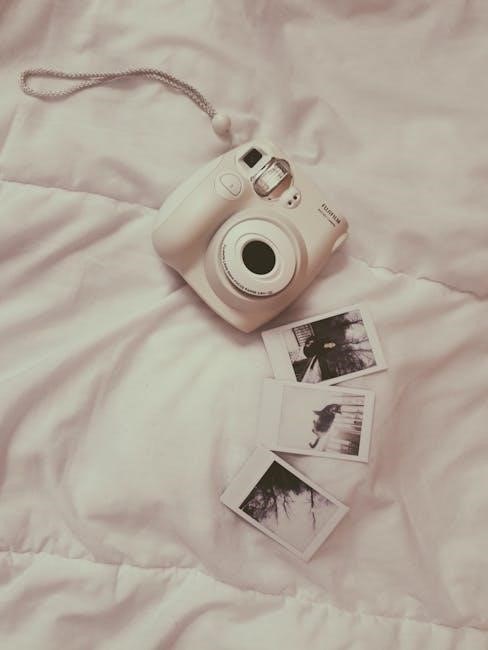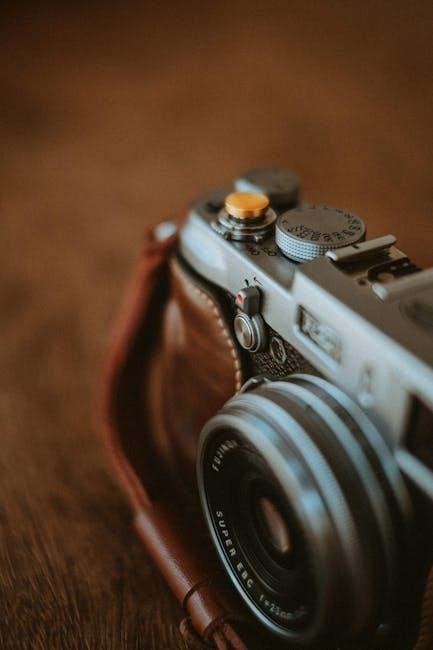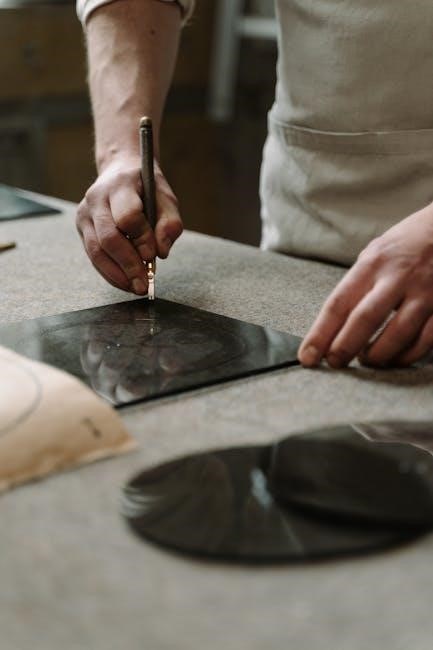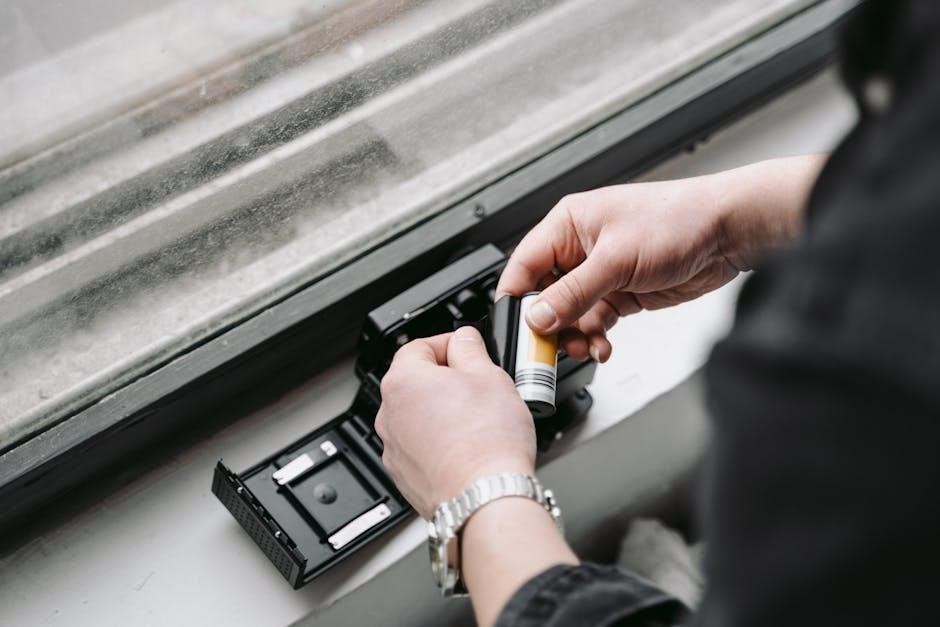Manual mode offers full control over camera settings, enabling creative photography. It’s not just for pros—mastering manual mode helps beginners unlock their camera’s potential and refine their craft.
1.1 What is Manual Mode and Why Use It?
Manual mode allows full control over aperture, shutter speed, and ISO, giving photographers creative freedom. It’s ideal for capturing precise lighting and effects. While it may seem complex, manual mode helps beginners understand how camera settings interact, leading to better image quality and artistic expression. It’s not just for pros—anyone can master it with practice and patience.
1.2 Benefits of Shooting in Manual Mode for Beginners
Shooting in manual mode empowers beginners to gain creative control and understand how exposure elements work together. It helps in mastering the exposure triangle, ensuring better image quality. While it requires patience, manual mode teaches photographers to adapt to lighting conditions and experiment with effects, fostering a deeper understanding of their camera and photography fundamentals.

Understanding Aperture in Manual Mode
Aperture, measured in f-stops, controls light entering the lens and depth of field. A lower f-stop means a larger aperture, creating a shallower focus and background blur.
2.1 Aperture Priority Mode Explained
Aperture Priority mode allows you to set the f-stop while the camera adjusts shutter speed for proper exposure. This mode is ideal for controlling depth of field, especially in portraits or landscapes, where focus is crucial. It simplifies manual adjustments, making it a great stepping stone for beginners before transitioning to full manual mode.
2.2 How Aperture Affects Depth of Field
Aperture controls depth of field, determining how much of the image is in focus. A lower f-stop (e.g., f/2.8) creates a shallow depth, blurring backgrounds, while a higher f-stop (e.g., f/11) keeps more of the image sharp. This is essential for portraits, landscapes, and capturing the desired visual emphasis in your photos.

Mastering Shutter Speed in Manual Mode
Shutter speed controls light and motion, with slower speeds (e.g., 1/30s) creating blur and faster speeds (e.g., 1/1000s) freezing action, allowing creative control over motion effects.
3.1 Shutter Priority Mode and Its Uses
Shutter Priority mode, often marked as S or Tv, allows you to set the shutter speed while the camera adjusts aperture. Ideal for capturing motion, it’s perfect for freezing fast-moving subjects, like sports, or creating artistic blur in waterfalls. This mode is a stepping stone to full manual control, helping beginners understand how shutter speed impacts the image.
3.2 Creative Effects of Different Shutter Speeds
Different shutter speeds create unique effects, enhancing storytelling in photos. Fast shutter speeds freeze action, capturing sharp details in dynamic scenes. Slower speeds blur motion, conveying movement and fluidity, ideal for waterfalls or sports. In low light, long exposures reveal artistic light trails or starry skies, adding depth and creativity to your images.

ISO Settings in Manual Mode
ISO controls light sensitivity, balancing exposure without changing aperture or shutter speed. Lower ISOs suit bright conditions, minimizing noise, while higher ISOs are used in low light, though risking grain.
4.1 Best Practices for Using ISO
For optimal results, use the lowest ISO possible in bright conditions to minimize noise. In low light, gradually increase ISO but avoid extremes to prevent grain. Always check your camera’s ISO range and adjust based on lighting to maintain image quality and clarity.
4.2 Reducing Noise in Low-Light Conditions
To minimize noise in low-light shots, use the lowest ISO necessary for proper exposure. Employ a tripod or image stabilization to avoid high ISOs. Shoot in RAW format for better post-processing control and apply noise reduction tools in editing software to refine your images effectively.
Step-by-Step Guide to Using Manual Mode
Master manual mode by starting with aperture or shutter priority, then transitioning to full control. Practice in good lighting and adjust settings based on histogram feedback.
5.1 Starting with Aperture or Shutter Priority
Begin by mastering one setting at a time. Use aperture priority for stationary subjects or shutter priority for motion. Adjust based on the scene, and use Live View to preview changes. This approach helps build confidence before transitioning to full manual mode, ensuring a strong foundation in understanding the exposure triangle;
5.2 Transitioning to Full Manual Mode
After mastering aperture or shutter priority, transition to full manual mode by adjusting all three settings. Start with aperture or shutter speed, then fine-tune the third. Use Live View to preview exposure changes and histograms to balance lighting. Practice in controlled environments to build confidence and refine your skills in capturing perfectly exposed images every time.
Exposure Triangle Cheat Sheet
The exposure triangle—aperture, shutter speed, and ISO—is the core of manual photography, enabling precise control over lighting and image quality for optimal results every time.
6.1 Balancing Aperture, Shutter Speed, and ISO
Balancing aperture, shutter speed, and ISO is key to achieving perfect exposure. Aperture controls depth of field, shutter speed freezes or blurs motion, and ISO adjusts sensitivity. Lower ISOs reduce noise, while larger apertures let more light in. Adjusting these elements harmoniously ensures well-lit, sharp images tailored to your creative vision, regardless of lighting conditions or subject movement. Proper balance enhances image quality and artistic intent.
6.2 Adjusting Settings for Different Lighting Conditions
Adapt your manual mode settings to lighting conditions for optimal results. In bright light, use a smaller aperture (higher f-stop) and faster shutter speed to avoid overexposure. In low light, widen the aperture and slow the shutter, or increase ISO carefully to maintain image quality. Balance these adjustments to ensure proper exposure, considering the scene’s dynamics and desired aesthetic effects while minimizing noise or blur. Consistent refinement enhances outcomes across various lighting scenarios.
Common Camera Settings for Beginners
Start with auto ISO for simplicity, then gradually adjust aperture, shutter speed, and ISO manually. Use live view to preview exposure and ensure balanced settings for your scene.
7.1 Recommended Starting Settings for Manual Mode
Begin with a mid-range aperture like f/2.8–f/5.6 for balanced depth of field. Set shutter speed between 1/125s–1/250s to avoid motion blur. Use auto ISO initially, then adjust manually for noise control. Start with lower ISOs (100–400) in bright light and increase in low light. Use live view to preview exposure and ensure settings align with your scene. Refer to a cheat sheet for guidance on initial manual mode configurations.
7.2 Using Live View for Previewing Exposure
Live View allows you to preview how your manual settings will affect the image. Enable it in manual mode to see real-time adjustments to aperture, shutter speed, and ISO. This feature, available on most modern cameras, helps you fine-tune exposure before capturing the shot, ensuring accuracy and desired results without trial and error. Use it to visualize your creative decisions instantly.
Tips for Practicing Manual Mode
Start with aperture or shutter priority modes to simplify learning. Practice in good lighting to build confidence, then gradually tackle challenging conditions to refine your skills effectively.
8.1 Shooting in Good Lighting Conditions
Good lighting simplifies manual mode basics, reducing the need for high ISOs and minimizing noise. Start with natural light or well-lit scenes to focus on aperture and shutter adjustments. Begin with aperture or shutter priority before transitioning to full manual. Use live view to preview exposure and ensure your shots are well-balanced and vibrant, making the learning process smoother and more enjoyable.
8.2 Gradually Increasing Difficulty
Start with simple scenarios, like stationary subjects in good light. As confidence grows, introduce motion or low-light conditions, adjusting ISO and shutter speed accordingly. Experiment with creative techniques like panning or freezing action. Gradual challenges help build proficiency, ensuring a smooth transition to more complex photography situations and refining your skills over time.
Cheat Sheets and Resources
Utilize printable cheat sheets and online tools to master manual mode. These resources provide quick guides for aperture, shutter speed, and ISO, simplifying learning and application.
9.1 Printable Cheat Sheets for Manual Mode
Printable cheat sheets are invaluable for mastering manual mode. They provide quick, easy-to-follow guides for aperture, ISO, and shutter speed settings. These sheets simplify complex concepts, offering visual aids and step-by-step instructions. Perfect for beginners, they ensure you never miss the perfect shot. Carry them as a handy reference to improve your skills on the go, even without internet access.
9.2 Online Tools for Learning Manual Settings
Online tools like interactive exposure calculators and camera simulators help beginners grasp manual settings. Websites offer step-by-step guides, video tutorials, and practice exercises. Communities and forums provide feedback on photos, while apps simulate manual mode for hands-on learning. These resources make mastering aperture, shutter speed, and ISO intuitive and accessible from anywhere with internet access.

Understanding Histograms
Histograms are tools for evaluating exposure, showing the tonal range of an image. They help identify overexposed or underexposed areas, guiding adjustments for balanced settings and optimal results.
10.1 What is a Histogram and How to Use It
A histogram is a graphical representation of an image’s tonal range, showing the distribution of light and dark areas. It helps photographers assess exposure, identify overexposed or underexposed regions, and make precise adjustments to aperture, shutter speed, or ISO for balanced results. By analyzing the histogram, beginners can ensure optimal exposure and enhance their photography skills effectively.
10.2 Adjusting Settings Based on Histogram Data
Interpret histogram peaks to identify overexposed or underexposed areas. If the graph touches the right edge, reduce aperture or shutter speed. For dark regions on the left, increase ISO or extend exposure time. Use live view to preview changes, ensuring balanced lighting and detail retention in your photos for optimal results.
Advanced Techniques and Mistakes to Avoid
Master advanced techniques like focus stacking and multiple exposures. Avoid common mistakes such as overcomplicating settings and ignoring focus accuracy. Simplify adjustments for better results.
11.1 Common Mistakes Beginners Make in Manual Mode
Beginners often overlook proper focus, causing blurry images. They may neglect the histogram, leading to overexposed or underexposed shots. Forgetting to adjust ISO in low light can introduce noise. Overcomplicating settings is another pitfall, as is not practicing consistently. These errors can hinder progress, but awareness and practice help refine skills effectively and efficiently.
11.2 Advanced Tips for Mastering Manual Mode
Mastering manual mode involves refining techniques like using live view for precise focus and adjusting settings based on histogram data; Shoot in RAW for post-processing flexibility. Experiment with creative effects like intentional blur or sharpness. Practice in various lighting conditions to develop instincts. Consistency and patience are key to elevating your photography skills and producing exceptional results.
